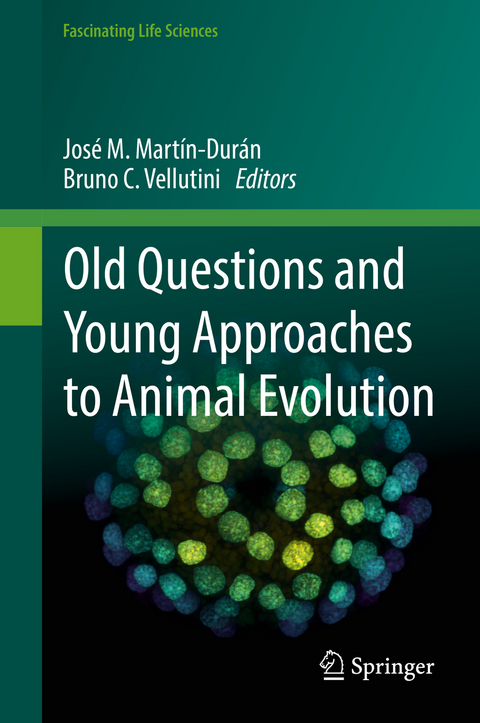
Old Questions and Young Approaches to Animal Evolution
Springer International Publishing (Verlag)
978-3-030-18201-4 (ISBN)
Animal evolution has always been at the core of Biology, but even today many fundamental questions remain open. The field of animal 'evo-devo' is leveraging recent technical and conceptual advances in development, paleontology, genomics and transcriptomics to propose radically different answers to traditional evolutionary controversies.
This book is divided into four parts, each of which approaches animal evolution from a different perspective. The first part (chapters 2 and 3) investigates how new sources of evidence have changed conventional views of animal origins, while the second (chapters 4-8) addresses the connection between embryogenesis and evolution, and the genesis of cellular, tissue and morphological diversity. The third part (chapters 9 and 10) investigates how big data in molecular biology is transforming our understanding of the mechanisms governing morphological change in animals. In closing, the fourth part (chapters 11-13) explores new theoretical andconceptual approaches to animal evolution.
'Old questions and young approaches to animal evolution' offers a comprehensive and updated view of animal evolutionary biology that will serve both as a first step into this fascinating field for students and university educators, and as a review of complementary approaches for researchers.
José M. Martín-Durán is a European Research Council Starting Grant Fellow and Senior Lecturer at Queen Mary University of London. He obtained his PhD in Genetics from the University of Barcelona, where he studied the embryonic development of planarian flatworms. After pursuing postdoctoral research at the Sars International Centre for Marine Molecular Biology, University of Bergen, he moved to Queen Mary University of London to establish a laboratory that combines his interests in developmental biology, animal evolution, and marine biodiversity. His lab applies genomic, epigenetic, and more classical developmental approaches to study the natural diversity in early embryogenesis found in spiralian lineages. Bruno C. Vellutini is an EMBO Fellow and postdoctoral researcher at the Max Planck Institute of Molecular Cell Biology and Genetics. He obtained his MSc in Zoology from the University of São Paulo, and his PhD in Molecular and Computational Biology from the University of Bergen, where he investigated the evolution of larval forms in marine invertebrates. His research focuses on understanding how changes in embryogenesis are connected to the evolution of animal morphology. Currently, he is combining genetic and live-imaging techniques to reveal the mechanisms that govern tissue morphogenesis in the fruit fly embryo.
Part 1. Animal Origins.- Chapter 1. 1. The protistan cellular and genomic roots of animal multicellularity.- Chapter 2. Exceptionally preserved Cambrian fossils in the genomic era.- Part 2. The developmental view of animal evolution.- Chapter 3. Comparative embryology as a way to understand evolution.- Chapter 4. How do developmental programs evolve?.- Chapter 5. How do morphological novelties evolve? Novel approaches to define novel morphologies.- Chapter 6. Germ layer evolution: using novel approaches to address a classic evolutionary embryological problem.- Chapter 7. Origin and evolution of nervous systems.- Part 3. The genomic view of animal evolution.- Chapter 8. Boosting macroevolution: genomic changes triggering qualitative expansions of regulatory potential.- Chapter 9. How do gene networks promote morphological evolution?.- Part 4. Theoretical approaches to animal evolution.- Chapter 10. How does modularity in the genotype-phenotype map shape development and evolution?.- Chapter 11. Can we compute the embryo?.- Chapter 12. What is a biological individual?.
"Excellent examples discussed throughout the book ... . Overall, this edited volume offers an enjoyable read and is a timely contribution for a wide range of evolutionary biologists interested in tackling and revisiting the many "big picture" questions in animal evolution." (Joshua R. York, The Quarterly Review of Biology, Vol. 96 (4), December, 2021)
“Excellent examples discussed throughout the book … . Overall, this edited volume offers an enjoyable read and is a timely contribution for a wide range of evolutionary biologists interested in tackling and revisiting the many “big picture” questions in animal evolution.” (Joshua R. York, The Quarterly Review of Biology, Vol. 96 (4), December, 2021)
| Erscheinungsdatum | 03.08.2019 |
|---|---|
| Reihe/Serie | Fascinating Life Sciences |
| Zusatzinfo | VI, 284 p. 50 illus., 42 illus. in color. |
| Verlagsort | Cham |
| Sprache | englisch |
| Maße | 155 x 235 mm |
| Gewicht | 720 g |
| Themenwelt | Naturwissenschaften ► Biologie ► Evolution |
| Naturwissenschaften ► Biologie ► Zoologie | |
| Naturwissenschaften ► Geowissenschaften ► Mineralogie / Paläontologie | |
| Schlagworte | Animal Development • Animal Diversification • Animal Embryogenesis • Animal Evolution • Animal Life History • Emergence of Animals • Evo-devo • Evolutionary History of Metazoans • evolutionary morphology • Germ Layer Theory • Molecular Phyolgeny • Phylogenomics |
| ISBN-10 | 3-030-18201-0 / 3030182010 |
| ISBN-13 | 978-3-030-18201-4 / 9783030182014 |
| Zustand | Neuware |
| Haben Sie eine Frage zum Produkt? |
aus dem Bereich


